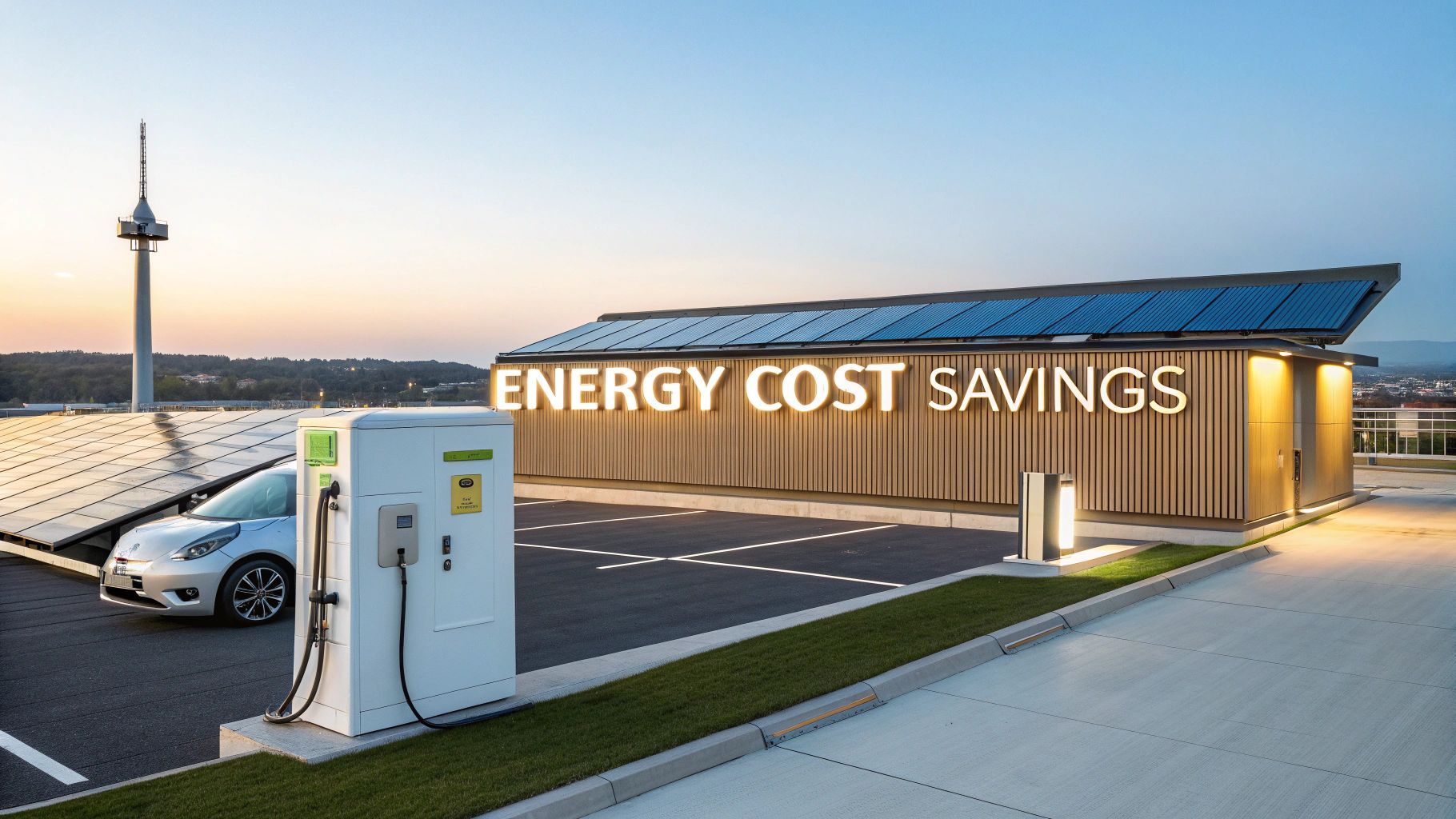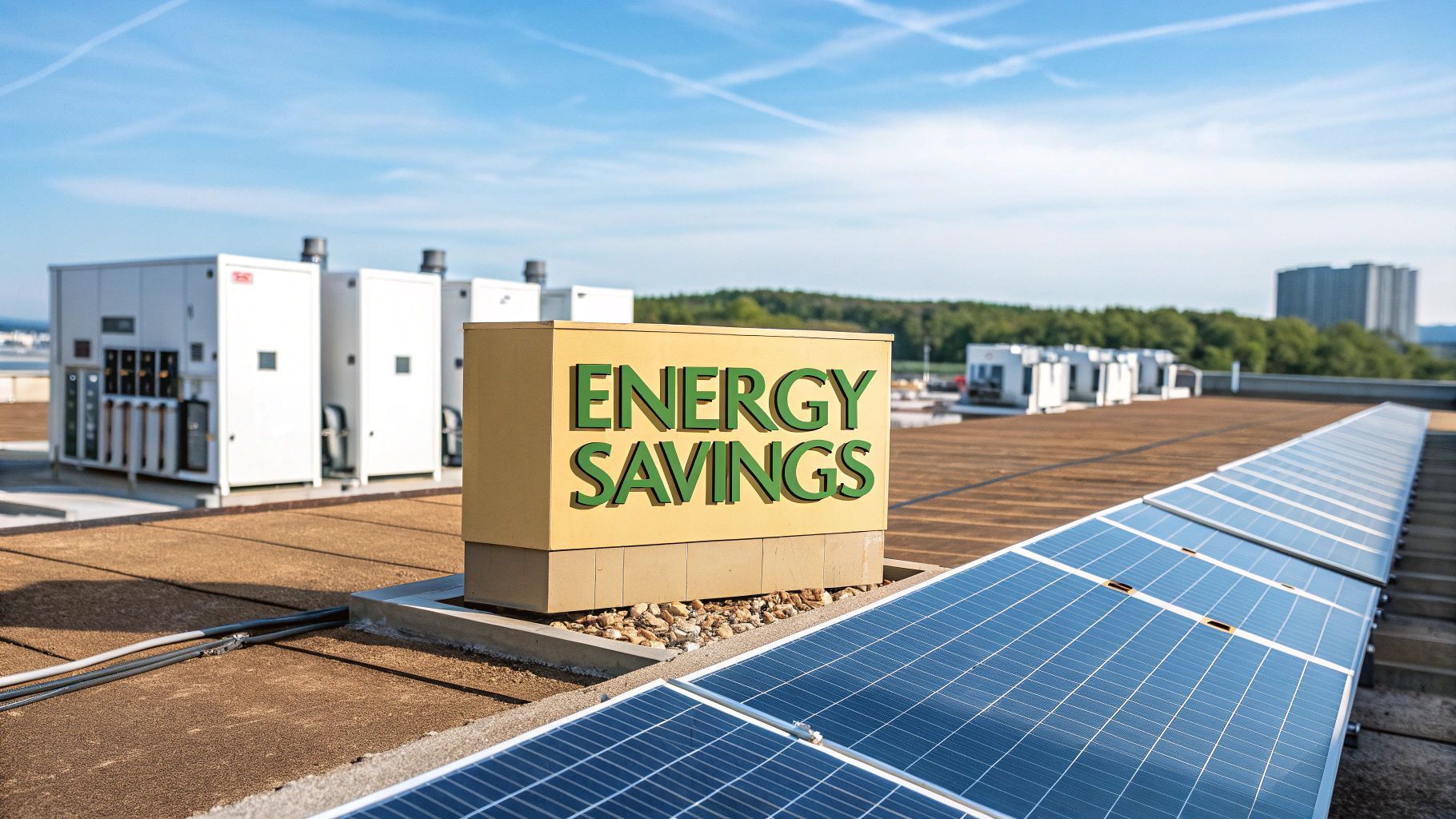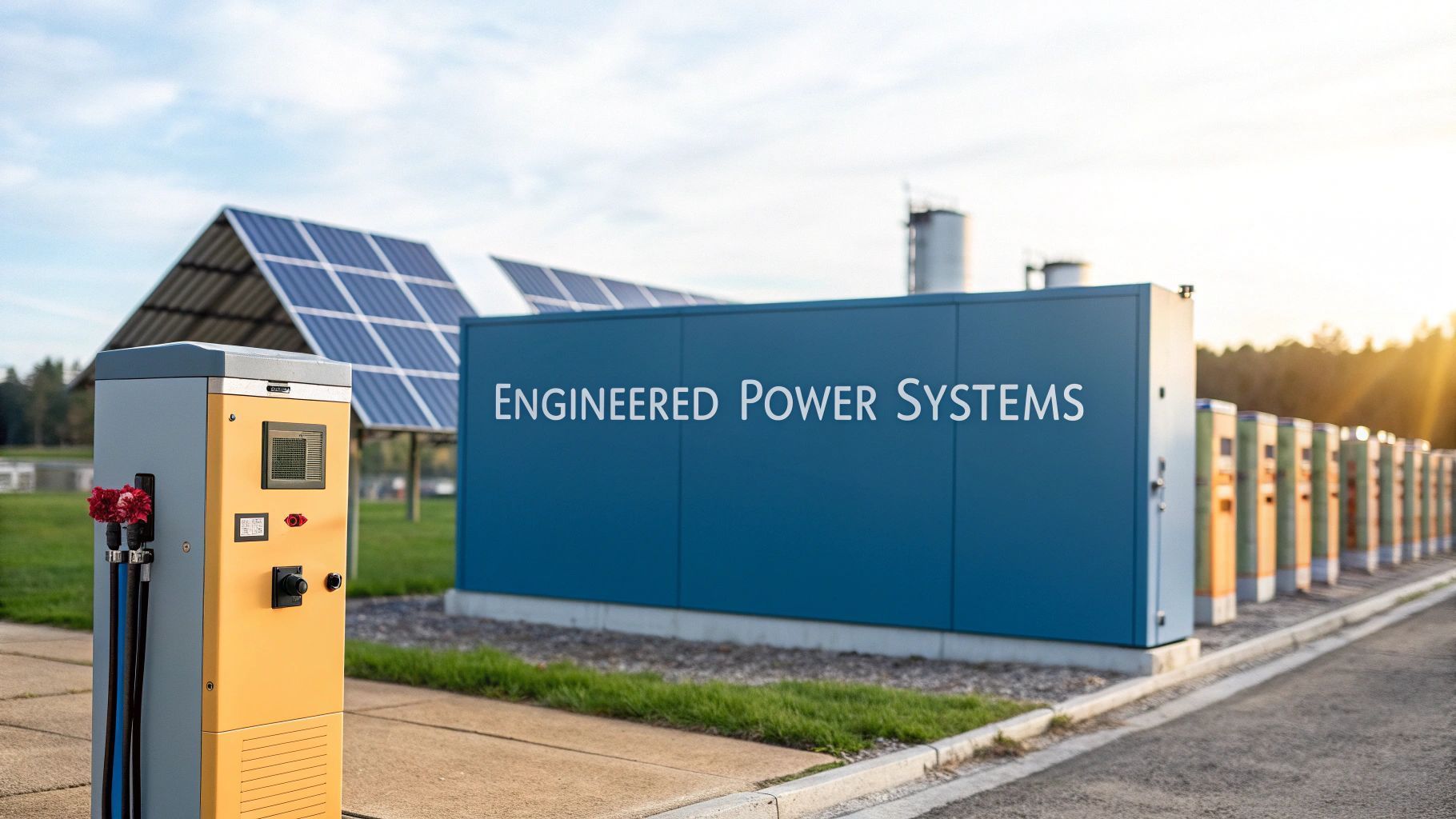A Guide to Electric Plugs in Chile for EV Charging
If you're planning to deploy EV charging infrastructure in Chile, the very first thing to understand is the national grid. It’s the bedrock of your entire operation. Think of it like the plumbing for your energy: get the pressure (voltage) and pulse (frequency) right from day one and you’ll avoid a world of headaches later.
Chile’s grid runs at a standard 220 volts (V) with a frequency of 50 hertz (Hz) . For any UK-based business this is good news. It’s remarkably similar to what we’re used to, creating a much smoother path for equipment compatibility compared to other parts of Latin America. We touch on these regional differences in our guide to voltage in Mexico but Chile’s consistency is a real advantage.
Plugs and Sockets Demystified
When you look at the wall sockets you’ll mainly find two types of electric plugs in Chile : Type C and Type L.
- Type C: This is the simple, two-pin plug you see all over Europe. While it's common it’s not earthed, which makes it a non-starter for serious, high-power equipment like dedicated EV chargers.
- Type L: This is the one to focus on. It’s a three-pin plug, with the pins arranged in a neat line. That third pin is the crucial earth connection, providing the safety and stability needed for higher-power appliances and, most importantly, for your EV charging installations.
To make things simple, here’s a quick-glance table summarising what you need to know.
Chilean Electrical System Quick Reference
| Specification | Details | Relevance for UK Operations |
|---|---|---|
| Voltage | 220 V | Highly compatible with UK equipment, which is designed for 230 V. |
| Frequency | 50 Hz | Identical to the UK standard, ensuring no timing or performance issues. |
| Common Plugs | Type C & Type L | Type L is essential for earthed, high-power EV charging hardware. |
| Grid Stability | Generally stable and reliable. | Provides a solid foundation for deploying advanced charging technology. |
This table shows just how aligned the Chilean and UK systems are, which simplifies the technical side of expanding your operations significantly.
A stable and predictable electrical grid is the bedrock of any successful EV charging network. Understanding Chile's 220V / 50Hz system allows fleet operators and businesses to select the right hardware from the outset, avoiding costly compatibility issues down the line.
Ultimately, this is about more than just picking the right adapter. This foundational knowledge shapes every major decision you'll make, from choosing charger specifications and vetting potential sites to deciding whether you need to integrate solutions like grid scale batteries to handle the demands of rapid EV charging. It’s the starting point for building a truly resilient and effective distributed energy strategy in Chile.
Deploying Commercial EV Charging Infrastructure
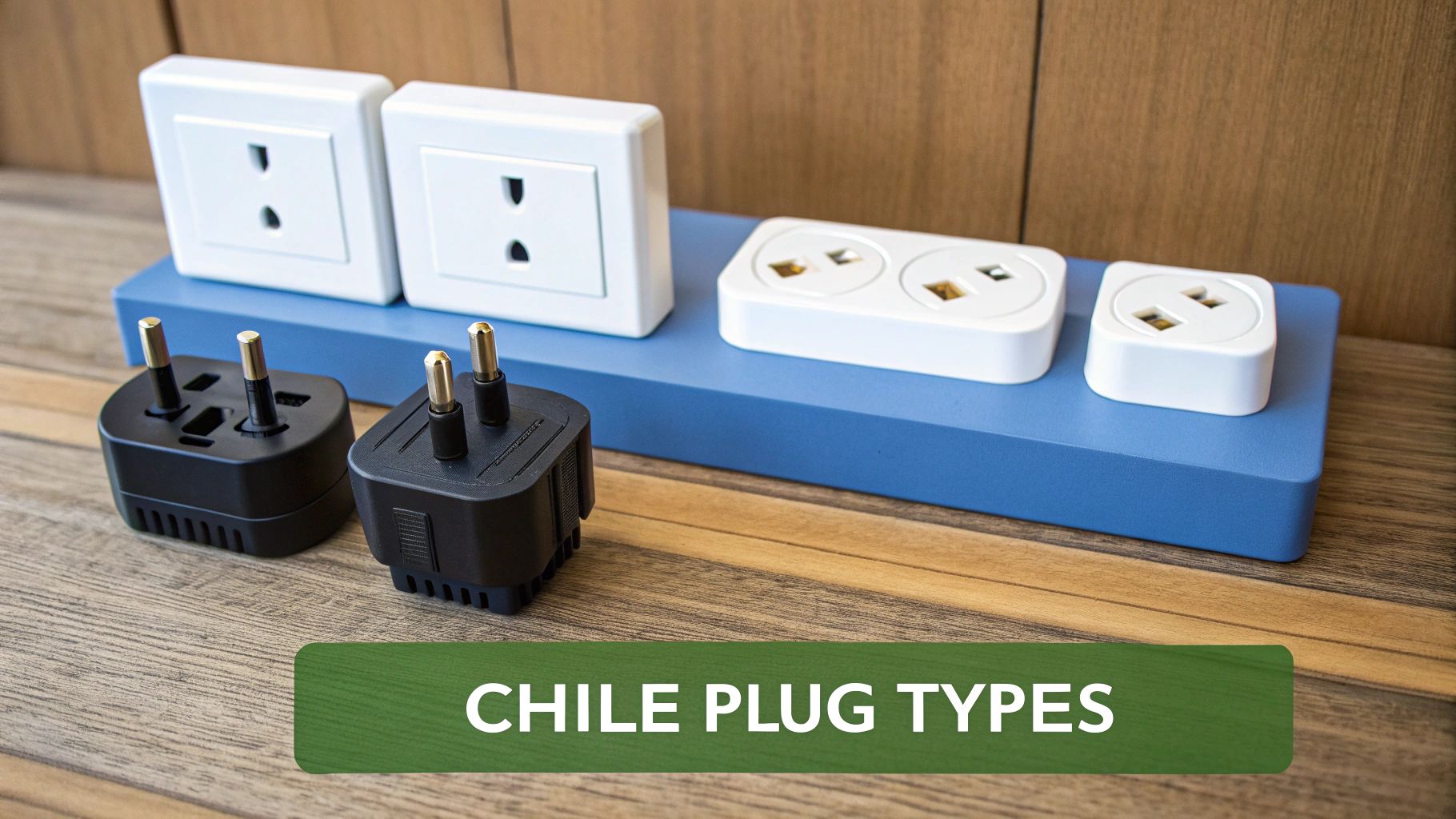
Once you’ve got a handle on Chile's electrical standards and the common electric plugs in Chile , it’s time to move from theory to practice. Putting commercial EV charging infrastructure in the ground requires smart planning and a real-world appreciation for what the local grid can actually handle. This isn't just about bolting hardware to the pavement; it's about building a reliable distributed energy ecosystem for your entire fleet.
The first big decision is choosing the right charging solution. For many, standard AC chargers are perfectly fine for overnight fleet charging. They can often tap into existing grid connections without needing major, expensive upgrades. On the other hand, high-power DC rapid EV charging is a different beast altogether. It places a massive demand on the electrical supply from a constrained grid connection and almost always requires significant grid reinforcement.
The Critical Planning Stages
Before you even think about breaking ground, a structured plan is your best defence against costly delays and a system that isn't fit for purpose. This process kicks off long before you purchase any equipment and is all about detailed site assessments and getting key people on board.
Here are the essential steps to nail down in the planning phase:
- Conducting a Thorough Site Assessment: Get boots on the ground. Evaluate the physical location for space, accessibility and how close it is to a decent power source. This initial survey is your chance to spot potential headaches early.
- Engaging with Local Utility Companies: This is non-negotiable. You absolutely must work with the local electricity provider to understand the grid’s capacity at your site and figure out what upgrades will be necessary.
- Navigating the Regulatory Landscape: Get familiar with Chilean regulations for electrical installations and EV charging infrastructure. Staying compliant is the key to a smooth rollout and avoiding operational problems down the line.
Evaluating Grid Capacity and First Steps
For any fleet manager the first and most important task is to get an accurate picture of a site's grid capacity. Think of it like checking the water pressure before installing an industrial sprinkler system—you have to be sure the supply can meet the demand. A professional electrical engineer can run a detailed analysis to confirm if your existing connection can support the charging load you’re planning.
The success of any commercial EV charging project in Chile hinges on a realistic assessment of the local grid. Underestimating the power demand of rapid EV charging is a classic mistake that can lead to project failure or a mountain of unforeseen costs.
This initial groundwork is the foundation of your entire deployment strategy. Beyond the specific challenges in Chile, simply understanding the different types of chargers is vital; for a wider view, you can explore a comprehensive guide to electric car charging stations. By methodically working through these planning stages, you can launch a commercial EV charging project that’s not only effective but also ready to scale as your fleet grows.
Overcoming Grid Constraints for Rapid Charging
When you’re looking to roll out rapid EV chargers, the type of electric plugs in Chile is just the start of the conversation. The real elephant in the room is often the local power grid itself. Most existing electrical networks were built long before anyone imagined the massive, sudden power draws needed for rapid EV charging.
Think of it like trying to fill several swimming pools at once using a single garden hose. The demand completely overwhelms the supply and the water pressure drops for everyone. That’s a pretty good picture of a constrained grid connection . Installing a bank of high-power chargers can easily swamp the local infrastructure, leading to instability or, in a worst-case scenario, power cuts.
This problem usually boils down to specific weak points in the grid. The local transformer might not have the capacity to handle the load or the substation feeding the whole area could already be running close to its limit. These are not small details; they are fundamental roadblocks that can bring a high-demand rapid EV charging installation to a grinding halt.
Diagnosing and Understanding Grid Weaknesses
The key is to identify these limitations before a single pound is spent. A thorough grid assessment isn't just a box-ticking exercise; it's the first essential step in figuring out if your chosen site is viable. This goes way beyond checking the on-site wiring and means taking a deep dive into the utility's infrastructure.
A proper grid assessment will cover a few critical areas:
- Transformer Capacity Analysis: Can the local transformer handle the extra load without overheating or failing?
- Substation Load Evaluation: Is there enough spare capacity at the nearest substation to support your new chargers?
- Cable and Feeder Scrutiny: Are the physical cables connecting your site to the grid thick enough to carry the current you need safely?
This concept map gives a clear overview of the core electrical specifications you need to get your head around for any installation in Chile.
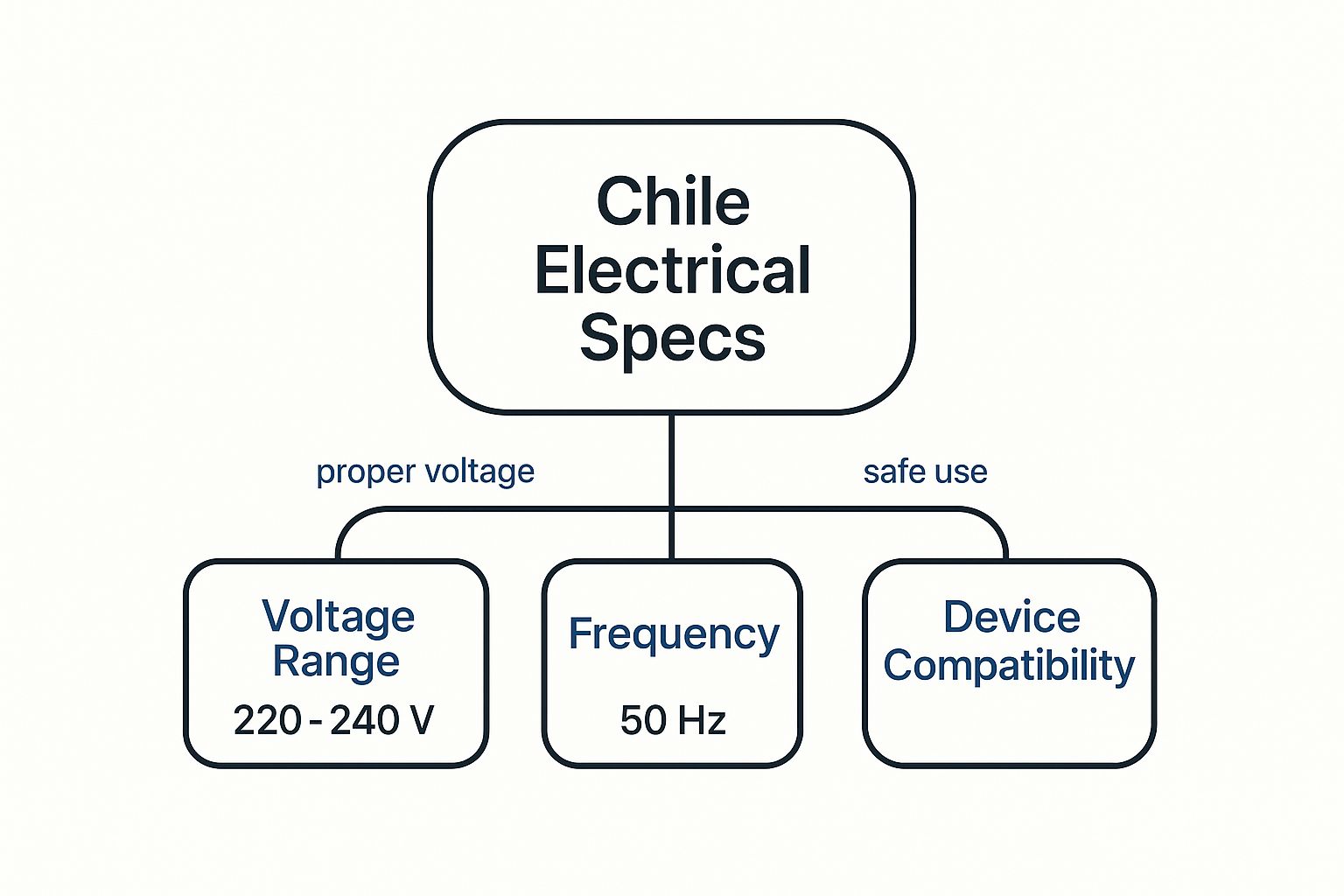
As the map shows, Chile’s 220–240 V range and 50 Hz frequency are a solid foundation, broadly compatible with UK and European equipment. This alignment definitely simplifies the process of choosing the right hardware.
Financial and Logistical Implications
Uncovering a constrained grid connection has serious knock-on effects, both financially and logistically. The cost of upgrading a local transformer or running new high-capacity lines from a substation can be eye-watering. It can also add months, sometimes even years, to your project timeline.
Understanding the grid's limitations upfront isn't about creating barriers; it's about realistic planning. A thorough assessment allows you to budget accurately for necessary upgrades or pivot to alternative solutions like on-site grid scale batteries, preventing costly surprises later on.
Adopting this realistic view is vital for any business. It transforms the grid assessment from a bureaucratic hurdle into a strategic tool for making sound investment decisions, ensuring your rapid EV charging project is built on solid ground from day one.
Using Batteries and Renewables for Smart Charging
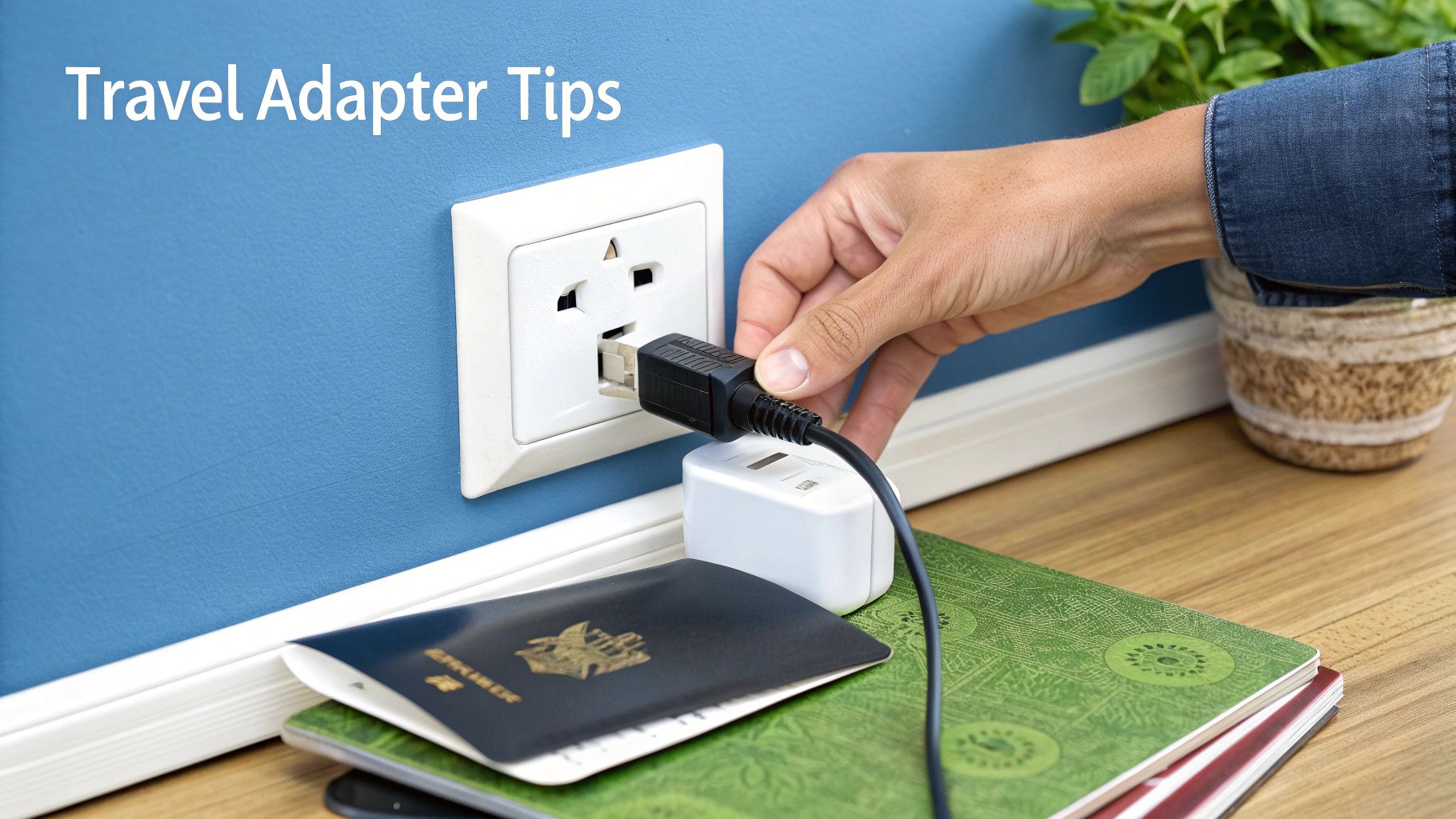
Grid constraints can feel like a major roadblock for anyone looking to install rapid EV charging but they are far from insurmountable. The real solution is to think differently about your site's energy—creating a self-sufficient ecosystem that partners with the grid instead of just taking from it. This is where combined on-site renewables play a key role.
This is exactly where on-site renewables and advanced battery storage come together. By pairing solar panels with grid scale batteries , businesses can build their own private power reserve. This setup lets you neatly sidestep the grid's limitations, creating a charging operation that's more resilient and cost-effective. It's an especially smart move when navigating the power demands of electric plugs in Chile .
How Grid Scale Batteries and Renewables Work Together
Think of a battery energy storage system as a financial shock absorber for your depot. During the day your solar panels are hard at work generating low-cost electricity. Instead of exporting all of that back to the grid for pennies, the battery system captures and stores it for when you really need it.
That stored energy can then be unleashed to power your rapid EV charging during peak times, like when your whole fleet returns for the evening. Or you can get clever and charge the batteries from the grid during the dead of night when electricity tariffs are at their absolute lowest. Either way you're storing cheap energy to dodge expensive peak rates.
A Battery Energy Storage System turns your EV charging and batteries from a simple energy user into an intelligent asset. It gives you control over not just when you use energy but also how much you pay for it.
This strategy, known as peak shaving , drastically cuts your reliance on the grid when it's most expensive and under the most strain. For a deeper dive into how this works in practice, our guide on battery-backed EV charging solutions has all the details.
A Real-World Scenario: A Logistics Depot
Let's picture a busy logistics depot in Santiago. The entire fleet of electric vans rolls back to base between 4 PM and 6 PM —the exact same time local grid demand and energy prices skyrocket. Trying to install a row of rapid chargers here would traditionally mean a very expensive grid upgrade.
But with an integrated solar and battery solution, the depot's day looks completely different:
- Daytime: Rooftop solar panels generate clean electricity, steadily charging the grid scale batteries all day long.
- Evening Peak: The fleet returns and plugs in. The rapid chargers draw their power straight from the fully-charged batteries, completely avoiding the strained local grid.
- Overnight: If needed, the battery system can top itself up using cheap, off-peak grid electricity, getting it ready for the next day's solar cycle.
This intelligent approach doesn't just eliminate the need for costly grid reinforcement; it slashes operational energy costs. It creates a sustainable charging model that is both economically smart and ready for anything.
This also aligns with the global push to harmonise electrical standards. Chile’s system runs at 220V and 50 Hz , which is incredibly close to the UK's 230V , making equipment compatibility much simpler. You can find more insights on this at electricalsafetyfirst.org.uk.
The Strategic Advantage of Mobile EV Charging
Fixed charging points are great but what happens when you need power where the grid can't easily reach? A more flexible approach is quickly gaining ground, especially for businesses grappling with grid limitations or constantly changing operational needs.
Mobile EV charging offers a powerful, adaptable solution for fleet operators, emergency services and companies working in remote spots where permanent infrastructure just isn't practical. It’s a shift away from a static, rigid model towards a much more dynamic energy network.
This flexibility is at the heart of what’s known as distributed energy . Instead of being tethered to a single point on the grid, mobile EV charging units function as roaming power sources, thanks to their own integrated batteries. They can actually support the local grid rather than straining it, delivering rapid EV charging exactly where it's needed—without the long-winded process of installing permanent connections. This is especially handy for managing the different power demands that come with the various electric plugs in Chile .
Dynamic Power for Real-World Scenarios
The practical uses for mobile EV charging are huge, offering solutions that fixed infrastructure simply can't match. These units aren't just chargers; they're self-contained energy hubs on wheels, giving businesses the agility to respond to almost any situation.
Just think about these scenarios:
- Temporary Event Power: Powering up a fleet of vehicles at a big outdoor festival or a remote construction site where there are no permanent chargers in sight.
- Emergency Fleet Support: During a blackout, mobile units can be sent out to keep critical emergency service vehicles charged and ready to go.
- Roadside Assistance: Giving a quick boost to a stranded EV, getting the driver back on the move without calling for a tow truck.
- Depot Overload Management: Backing up fixed chargers at a busy logistics hub during peak times, making sure every vehicle is charged for the next shift without long queues.
Mobile EV charging transforms energy from a fixed utility into a deployable asset. It allows businesses to respond to immediate needs, overcome constrained grid connections and maintain operational continuity, no matter the location or situation.
This strategic flexibility is a game-changer for fleet management. It completely decouples charging from a specific physical location, allowing businesses to rethink their entire energy strategy. To see how these units are delivering portable power with a permanent impact, you can learn more about the rise of ZPN’s mobile charging units. By bringing mobile solutions into the mix, companies can build a far more robust and responsive charging network.
Future-Proofing Your EV Fleet Strategy
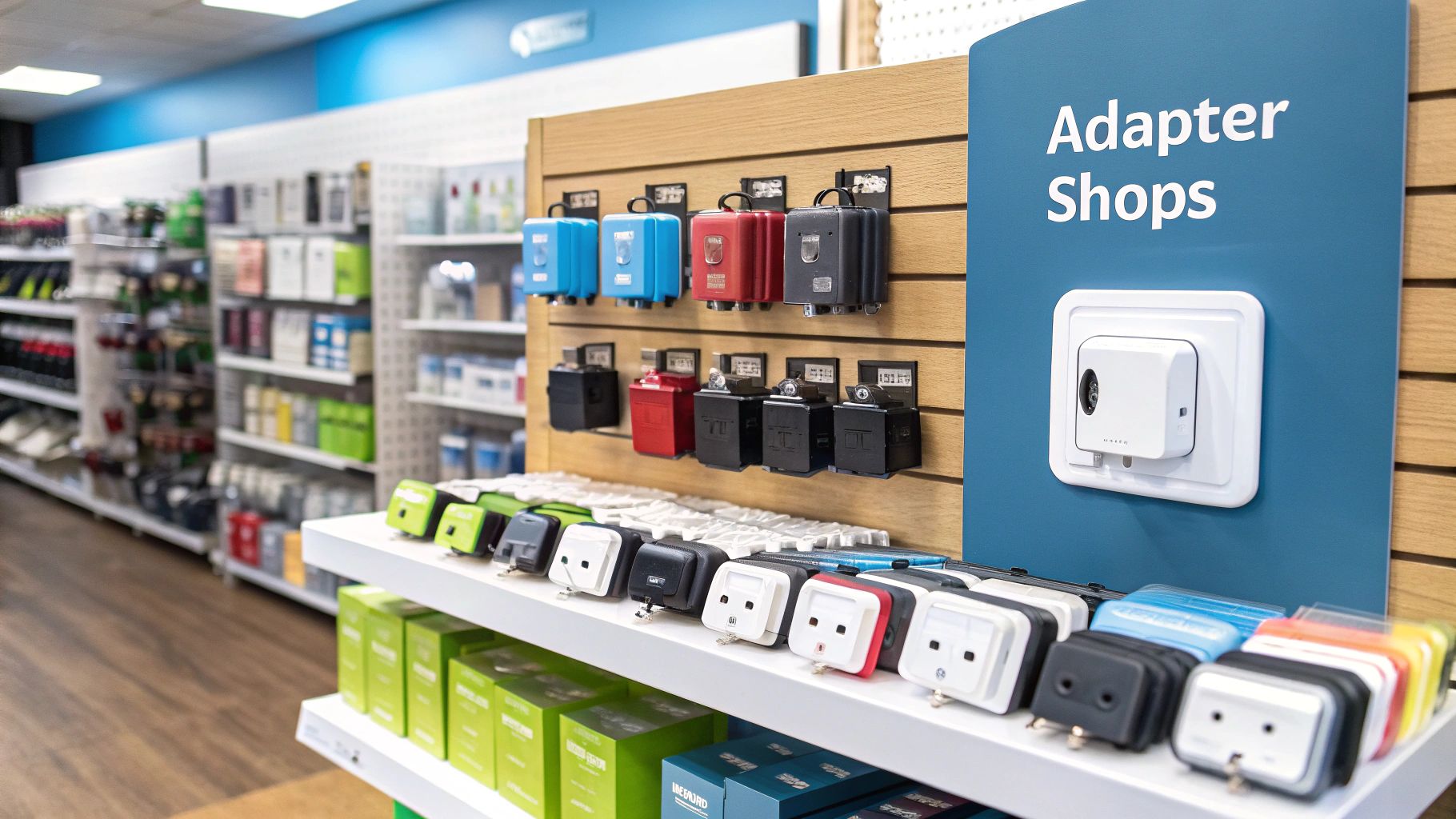
Shifting your fleet to electric vehicles in Chile is a massive undertaking. It's about much more than just buying new vans and plugging them in. What it really demands is a smart, forward-thinking energy strategy—one that anticipates everything from basic hardware compatibility to long-term grid stability. Let's pull together everything we've covered into a clear blueprint for your business.
The journey has to start with the fundamentals. Getting a solid grasp of Chile's standard 220V / 50Hz grid and its common Type C and Type L electric plugs in Chile is the absolute first step. It’s non-negotiable. This groundwork ensures your first hardware choices are the right ones, saving you from costly mismatches right out of the gate.
Building a Resilient Energy Ecosystem
Once you've nailed the basics the focus has to shift to the much bigger challenge: constrained grid connections. Rapid EV charging puts a huge strain on local infrastructure and simply hoping there's enough power isn't a viable long-term solution. You need a smarter approach to guarantee reliability and keep your operational costs in check.
The most effective strategies are built around creating a degree of energy independence. This means you need to stop thinking of grid-scale batteries, on-site renewables and mobile EV charging as optional extras. They are essential parts of an intelligent, distributed energy plan. By generating and storing your own power, you insulate your fleet from the grid's limitations and shield your budget from volatile energy prices.
A truly future-proof EV strategy in Chile moves beyond simple charging infrastructure. It integrates on-site generation and storage to create a resilient, cost-effective and sustainable distributed energy ecosystem for your entire operation.
A Strategic Checklist for Fleet Operators
To make sure your transition is a success you need a holistic view. This checklist breaks down the key things to consider when building a dependable and efficient charging network for your fleet in Chile.
- Grid Capacity Assessment: Before you do anything else get a professional evaluation of the grid connection at every site you're considering. Don't skip this.
- Integrated Energy Solutions: Run the numbers on combining solar generation with grid scale batteries. This is how you reduce reliance on the grid and slash long-term costs.
- Flexible Charging Options: Look into adding mobile EV charging to your strategy. It provides fantastic operational flexibility, helps support remote assets and is a lifesaver during power outages.
- Scalability Planning: Design your infrastructure for the fleet you have today but have a crystal-clear plan for how you'll expand it as your EV numbers inevitably grow.
Got a Question?
We get asked a lot about the practicalities of setting up electrical equipment and EV charging in Chile. Here are some of the most common queries, answered directly to help you get your project off the ground.
Will My UK Appliances Work in Chile, or Do I Need a Voltage Converter?
In most cases you won't need a voltage converter. Chile's 220V standard is a very close match for the UK's 230V , which sits comfortably within the tolerance level of almost all modern electronics.
What you will absolutely need though is a physical plug adaptor. This will let you connect your UK-style Type G plug into Chile’s Type C or Type L sockets. Still, it’s always smart to have a quick look at the voltage rating printed on your specific appliance before you plug anything in.
What's the First Thing I Should Do to Install a Rapid EV Charger?
Before you even think about buying hardware your first and most critical step is to get a professional grid connection assessment done at your proposed site. You absolutely must confirm that the local electricity supply can handle the massive power draw rapid EV charging demands from a constrained grid connection.
This isn't a quick check; it involves detailed talks with the local utility provider and bringing in a qualified electrical engineering specialist. The results of this assessment will tell you if the project is even viable and what grid upgrades, if any, will be needed to make it happen.
A key benefit of integrating grid scale batteries is their ability to provide resilient power. When correctly configured, a BESS combined with combined on-site renewables like solar can ensure your EV chargers remain operational during a local power cut, guaranteeing business continuity for your fleet.
For cutting-edge rapid EV charging solutions and integrated energy management systems designed for the Chilean market, trust the experts at ZPN Energy . Discover how our technology can future-proof your fleet at https://www.zpnenergy.com.


